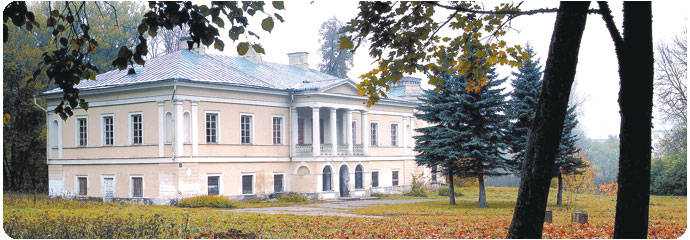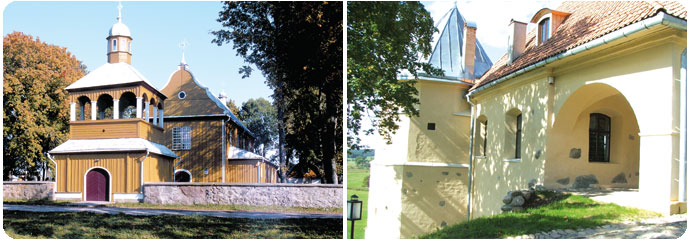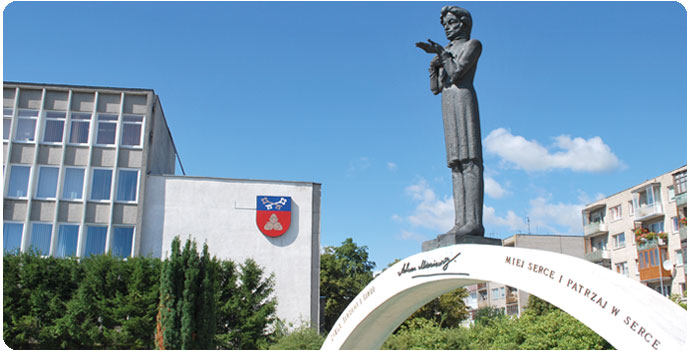Šalčininkai district exists in picturesquely southeast part of Lithuania. This
is the land where the Polish compose the majority so ethnographic culture of the district
differs from the neighboring territories. 79 percent of district residents are Polish
people, 9.4 percent – Lithuanians, 5.8 percent – Russians, 3.8 percent –
Byelorussians, 1.4 percent – of other nationality.
It is worth to come here for many reasons. Beautiful churches and estates, mythological
stones and mounds waved by the legends, unique buildings of old villages and lovely
landscapes – all this can be seen by the tourists traveling through Šalčininkai
district.
Here you will be met by good and laborious people cherishing old traditions and also who
are open for innovations.
Šalčininkai land will fulfill the suspense of those who will search the peace in the
envelopment of nature and of those who wants to step forth the step to the world of
business and realize studies.
 |
| Jašiūnai |
|
VISITING OBJECTS
• Šalčininkai
The centre of the district – Šalčininkai are at 45 km from Vilnius, at Vilniaus-Lydos
highway. 7000 residents live here. Since 1998 the municipality of Šalčininkai is being
decorated by the monument for Adomas Mickevičius. After the year at recreational centre
of Šalčininkai the monument was set for one of the commanders of 1863 rebellion –
Konstantinas Kalinauskas.
Vagneriai palace in written sources is mentioned since XIV century. They are one of the
most beautiful estates in Vilnius land. The estate was governed by Hlebovičiai, grandees
Chodkevičiai. The last governors of the estate – graphs Vagneriai.
In 1880 Vitoldas Vagneris had built neo-classicistic mansion-house where currently S.
Moniuška art school is established.
On the edge of the city, at the road guiding to Vilnius masonry chapel of the authorship
of Laurynas Stuoka-Gucevičius flaunts. It was built in XVIII century.
• Jašiūnai
In XV–XVIII century Jašiūnai had belonged to at that date one of the most powerful and
richest grandee’s families – Radvilos. Jašiūnai estate was bought by Ignotas
Balinskis in 1811. After his death the estate had come to his junior sun Mykolas
Balinskis. After in 1820 he had married the eldest daughter of Vilnius university
professor chemist Andrius Sniadeckis – Sofija Sniadecka, Sniadeckiai family had dwelled
in Jašiūnai. On J. Sniadeckis initiative and finance in 1824–1828 in accordance to the
project of Vilnius university architecture professor Karolis Podčašinskis gorgeous
palace of late classicism style was built.
Jašiūnai was important cultural centre of last century. A lot of famous people had lived
and visited this place: Tomaš Zan, Antonis Edvardas Odinecas, Juzefas Miankovskis, priest
Stanislovas Bonifacas Jundzilas, bishop Laurynas Puttkamer, priest Povilas Bžostovskis,
Julijus Slovackis.
• Pavlovas Republic
Near the road Jašiūnai–Turgeliai there is famous Pavlovas Republic made out in 1767–1791
and that was established by Povilas Bžostovskis. In 1767 m. he had bought Merkinė estate
and surrounding lands and after two year he had published lot of reforms: he had abolished
pays in the dominions, distributed the land to the peasants and introduced expiatory
charge. Pavlovas Republic had included the area of 3 thousands hectares, had its own
Constitution, blazon, money, parliament, treasury, benefit-society, police, doctor,
school. This Republic had survived for almost 30 years. Only the walls of formal
magnificent two-storey palace and rubble of other three other buildings had remained till
today.
 |
| Tabariškės |
Norviliškės |
• Tabariškės
St. Archangel Michael church is the oldest church the district. Famous artist Ana Krepštul
had lived in small house existed on the edge of the village that had painted more than 3.5
thousand pictures. Her works were displayed in various expositions, the museums; they are
acquired by private collectors and churches. The pictures of Ana Krepštul are mostly
protected in private collections and churches.
• Rūdninkai and Rūdninkai forest
Rūdninkai is the villages established at the right bank of Merkys, in Rūdninkai forest.
This is historical but not well-known place because no historical traces remained.
1/6 territory of Šalčininkai district is taken by Rūdninkai forest having the area of
26000 hectares. In XV–XVII century the forest was well-liked hunting place of the dukes.
In 1470 Kazimieras Jogailaitis had built hunting estate in Rūdninkai forest. In May of
1554 in one of the rooms of this estate Žygimantas Augustas had laid the body of his
second wife Barbora Radvilaitė waiting when during the transportation from Cracow to
Vilnius the place for burying will be appointed in Vilnius Cathedral.
Biotop complex of Rūdninkai forest is one of the most valuable territories of the
district.
• Dieveniškės and Dieveniškės Regional Park
Dieveniškės is typical village example of old Lithuanian lands that southeast places of
the Republic of Lithuania and neighboring Belorussian places are ascribable to. The most
important elements of Dieveniškės urban monument – square park involving five
historical roads. They had connected the town with Vilnius, Ašmena, Trobos (Subatninkai),
Geranainimis, Šalčininkai. Important historical monument – Rosary Church of the
Blessed Virgin Mary that was built in
1907. Masonry belfry of 21 meters height was built in 1903 facing the church. It includes
almost 200 year old bells. Dieveniškės historical Regional Park extends Gauja onshore.
Its area – 108 km2. One of the most interesting villages of Dieveniškės surroundings
– Žižmai. This street striped village – architectural monument of local meaning. 8
homesteads are marked with memorial plaques. These homesteads include 28 buildings of the
end of XIX century and the firs half of XX century.
• Norviliškės
In XVI century Norviliškės economic and administrative complex had belonged to Vaitiekus
and Dorota Šorcai and in 1617 junior widow had alienated the buildings to Franciscan
little brothers order. In the beginning of XVII century the monastery had be built here
and eight monks had dwelled. Unfortunately the monastery had get into the list of closing
ones and the barracks of tsar’s soldiers were appointed. In 1900 – 1915 the students
of Agricultural school had lived there. In 1918 the monastery and belfry were fitted for
the presbytery and in 1928 modern church was built. Now Norviliškės castle is well-known
tourist complex.
• Eišiškės
The name of the city is associated with the name of historical person nobleman Eišis (Eikšis)
(he was one of the generals of fabulous duke Erdvilas). The first Catholic Church had
towered here in 1398, immediately after christening of Lithuanian by the order of Vytautas
the Great. Eišiškės grave place reminds this period. The residues of the ditches and
embankments effectively look nowadays also. In 1678 the king Jonas Sobieskis had provided
the rights of Magdeburgas for Eišiškės. Eišiškės had developed as multinational
town. Since the year Polish people, Lithuanians, Russians, Byelorussians, gypsies and
Jewry had lived here. It is worth to visit Eišiškės church built in 1847–1852 in
accordance to the project of engineer Teodoras Narbutas. Eišiškės includes Jewish
cemetery.
At 3 km from Eišiškės Gornostajiškės village exists where Sekluckiai estate can be
seen. In 1986 the monument for the originator of Lithuania writing Stanislavas Rapolionis
native from the surroundings of Eišiškės had towered facing the house of the estate.
|





